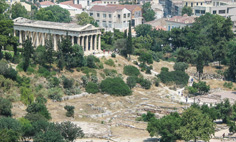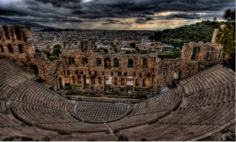
Being one of the most historically significant cities in Europe, Athens has much to offer to those who are interested in exploring some of the routes of our world’s civilization. Over the years, a multitude of conquerors occupied Athens, and erected unique and truly splendid monuments. Today’s capital integrates the ancient and medieval history into the contemporary era. Monuments can be found all around the city center, side by side with contemporary constructions such as buildings, roads and train stations.
Acropolis
 The Acropolis is the most important monument of Ancient Greek civilization. The main building, Parthenon, was dedicated to Athena Parthenos, the patron Goddess of the city and was completed in 432 BC. Unique in its beauty, like all ancient monuments, it has suffered destruction and theft, but thankfully, just under the hill where the monument stands on, there is the Acropolis Museum providing all the missing pieces of information needed for someone to understand its significance, and all the stories it has played a role in throughout the years.
The Acropolis is the most important monument of Ancient Greek civilization. The main building, Parthenon, was dedicated to Athena Parthenos, the patron Goddess of the city and was completed in 432 BC. Unique in its beauty, like all ancient monuments, it has suffered destruction and theft, but thankfully, just under the hill where the monument stands on, there is the Acropolis Museum providing all the missing pieces of information needed for someone to understand its significance, and all the stories it has played a role in throughout the years.
Hadrian’s Arch and the Temple of Olympian Zeus.
 Before starting the climb to get to the Parthenon, it is impossible to miss a monument as impressive as Hadrian’s Arch. Constructed in 131 AD by the Roman Emperor, it was created to form an entrance for the new city and separate it from the old one. From the side of the monument that faces the Acropolis, one can see the inscription “This is Athens, the former city of Theseus”, while on the other side “This is the city of Hadrian and not of Theseus”.
Before starting the climb to get to the Parthenon, it is impossible to miss a monument as impressive as Hadrian’s Arch. Constructed in 131 AD by the Roman Emperor, it was created to form an entrance for the new city and separate it from the old one. From the side of the monument that faces the Acropolis, one can see the inscription “This is Athens, the former city of Theseus”, while on the other side “This is the city of Hadrian and not of Theseus”.
 Behind Hadrian’s Arch, stands the captivating temple of Olympian Zeus. The building process started in the 6th century by Peisistratos, and was finally finished 100 years later, in 131 AD by Emperor Hadrian. Originally, it consisted of 104 Corinthian columns, of which only 15 remain standing today. Inside the temple, Hadrian built an enormous gold and ivory statue of Zeus and an equal one of himself. To this day, we do not know when the temple was destroyed, but like many other large buildings in Greece, it is possible that it was brought down by an earthquake during the mediaeval period and the ruins sold for other building materials.
Behind Hadrian’s Arch, stands the captivating temple of Olympian Zeus. The building process started in the 6th century by Peisistratos, and was finally finished 100 years later, in 131 AD by Emperor Hadrian. Originally, it consisted of 104 Corinthian columns, of which only 15 remain standing today. Inside the temple, Hadrian built an enormous gold and ivory statue of Zeus and an equal one of himself. To this day, we do not know when the temple was destroyed, but like many other large buildings in Greece, it is possible that it was brought down by an earthquake during the mediaeval period and the ruins sold for other building materials.
Ancient Agora
 The Ancient Agora, which means “market” in modern Greek, is situated at the footsteps of the Acropolis. In ancient times it served as the commercial centre of the city, but also as a political, cultural and religious centre. Today it resembles a park and is a peaceful area that can be explored either on foot or by bicycle, giving people a vivid visual of the everyday life of an ancient Athenian.
The Ancient Agora, which means “market” in modern Greek, is situated at the footsteps of the Acropolis. In ancient times it served as the commercial centre of the city, but also as a political, cultural and religious centre. Today it resembles a park and is a peaceful area that can be explored either on foot or by bicycle, giving people a vivid visual of the everyday life of an ancient Athenian.
Panathenaic Stadium
 Originally built in the 4th century B.C. for the athletic competitions of the Great Panathinaia (ancient Greek festivities), the “Kallimarmaron” Stadium was the venue of the first modern Olympic Games, in 1896.
Originally built in the 4th century B.C. for the athletic competitions of the Great Panathinaia (ancient Greek festivities), the “Kallimarmaron” Stadium was the venue of the first modern Olympic Games, in 1896.
A creation of the Athenians, as its name proudly proclaims, the Panathenaic Stadium has been the venue for noble competition and fair play, of mind and of body, since Antiquity.
Herodes Atticus Theatre
 Built at the base of the Acropolis, the ancient amphitheatre of Herodeion, also known as the Odeon of Herodus Atticus, is one of the best places to experience a live classical theatre performance. This ancient theater was built in the Roman times, in about 161 A.D. by the Roman philosopher, teacher and politician Herodes Atticus. It was built in the memory of his wife Aspasia Regilla, who died in 160 AD and is still used for various performances.
Built at the base of the Acropolis, the ancient amphitheatre of Herodeion, also known as the Odeon of Herodus Atticus, is one of the best places to experience a live classical theatre performance. This ancient theater was built in the Roman times, in about 161 A.D. by the Roman philosopher, teacher and politician Herodes Atticus. It was built in the memory of his wife Aspasia Regilla, who died in 160 AD and is still used for various performances.
Museums of Athens
The Acropolis Museum
The Acropolis Museum was founded in 2003 and completed in 2007, after decades of being born as an idea, as a place that would accommodate the missing Parthenon sculptures. Today it is focused on the findings of the archaeological site of the Acropolis of Athens. The museum was built to house every artifact found on the rock and on the surrounding slopes, from the Greek Bronze Age to Roman and Byzantine Greece. It also lies over the ruins of a part of Roman and early Byzantine Athens.
http://www.theacropolismuseum.gr/en/
National Archaeological Museum of Athens
The National Archaeological Museum of Athens is the largest in Greece and one of the most important museums in the world devoted to ancient Greek art. It was founded at the end of the 19th century to house and protect antiquities from all over Greece, thus displaying their historical, cultural and artistic value.
http://www.namuseum.gr/wellcome-en.html
Byzantine & Christian Museum
The Byzantine and Christian Museum, which is based in Athens, is one of Greece’s national museums. Its areas of competency are centered on – but not limited to – religious artefacts of the Early Christian, Byzantine, Medieval, post-Byzantine and later periods. The Museum has over 25.000 artifacts in its possession, which date from between the 3rd and 20th Century A.D.
http://www.byzantinemuseum.gr/en/
Museum of Cycladic Art
The Museum of Cycladic Art is dedicated to the study and promotion of ancient cultures of the Aegean and Cyprus, with special emphasis on Cycladic Art of the 3rd millennium BC. It was founded in 1986, to house the collection of Nicholas and Dolly Goulandris, an extensive and unique private collection of prehistoric art from the Cycladic islands as well as ancient Greece.
Benaki Museum
The Benaki Museum ranks among the major institutions that have enriched the material assets of the Greek state. It houses 30.000 items illustrating the character of the Greek world through a spectacular historical panorama covering several periods ranging from the Prehistoric, Ancient and Roman periods to the Byzantine and the contemporary Hellenic period.
https://www.benaki.gr/index.php?lang=en
Hellenic Cosmos Cultural Center of the Foundation of Hellenic World
A living museum, an ultramodern cultural center, where visitors can learn about history, culture and sciences through interactive exhibitions, educational programs, virtual reality shows and documentaries.



